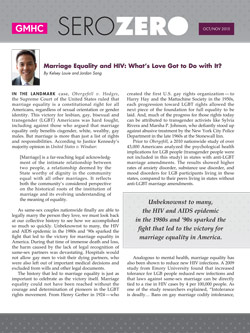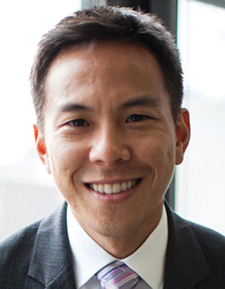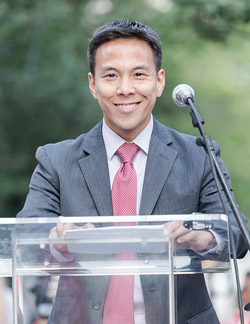 In the landmark case, Obergefell v. Hodges, the Supreme Court of the United States ruled that marriage equality is a constitutional right for all Americans, regardless of sexual orientation or gender identity. This victory for lesbian, gay, bisexual and transgender (LGBT) Americans was hard fought, including against those who argued that marriage equality only benefits cisgender, white, wealthy, gay males. But marriage is more than just a list of rights and responsibilities. According to Justice Kennedy’s majority opinion in United States v. Windsor:
In the landmark case, Obergefell v. Hodges, the Supreme Court of the United States ruled that marriage equality is a constitutional right for all Americans, regardless of sexual orientation or gender identity. This victory for lesbian, gay, bisexual and transgender (LGBT) Americans was hard fought, including against those who argued that marriage equality only benefits cisgender, white, wealthy, gay males. But marriage is more than just a list of rights and responsibilities. According to Justice Kennedy’s majority opinion in United States v. Windsor:
[Marriage] is a far-reaching legal acknowledgment of the intimate relationship between two people, a relationship deemed by the State worthy of dignity in the community equal with all other marriages. It reflects both the community’s considered perspective on the historical roots of the institution of marriage and its evolving understanding of the meaning of equality.
 |
| Kelsey Louie |
As same-sex couples nationwide finally are able to legally marry the person they love, we must look back at our collective history to see how we accomplished so much so quickly. Unbeknownst to many, the HIV and AIDS epidemic in the 1980s and ’90s sparked the fight that led to the victory for marriage equality in America. During that time of immense death and loss, the harm caused by the lack of legal recognition of same-sex partners was devastating. Hospitals would not allow gay men to visit their dying partners, who were also left out of important medical decisions and excluded from wills and other legal documents.
The history that led to marriage equality is just as important to celebrate as the victory itself. Marriage equality could not have been reached without the courage and determination of pioneers in the LGBT rights movement. From Henry Gerber in 1924 — who created the first U.S. gay rights organization — to Harry Hay and the Mattachine Society in the 1950s, each progression toward LGBT rights allowed the next piece of the foundation for full equality to be laid. And, much of the progress for those rights today can be attributed to transgender activists like Sylvia Rivera and Marsha P. Johnson, who defiantly stood up against abusive treatment by the New York City Police Department in the late 1960s at the Stonewall Inn.
 |
| Jordan Sang |
Prior to Obergefell, a 2010 nationwide study of over 43,000 Americans analyzed the psychological health implications for LGB people (transgender people were not included in this study) in states with anti-LGBT marriage amendments. The results showed higher rates of anxiety disorder, substance use disorder, and mood disorders for LGB participants living in these states, compared to their peers living in states without anti-LGBT marriage amendments.
Analogous to mental health, marriage equality has also been shown to reduce new HIV infections. A 2009 study from Emory University found that increased tolerance for LGB people reduced new infections and that laws against same-sex marriage can be directly tied to a rise in HIV cases by 4 per 100,000 people. As one of the study researchers explained, “Intolerance is deadly… Bans on gay marriage codify intolerance, causing more gay people to shift to underground sexual behaviors that carry more risk.”
Not surprising, these findings highlight the harmful effects of bigotry and stigma. When society becomes more accepting and discrimination decreases, we see an improvement in the health and lives of LGBT individuals. These findings also demonstrate the importance of marriage equality as a structural determinant of health, with broad implications. Undoubtedly, marriage is a fundamental right that plays a key role in improving the health of LGBT individuals, including those at high risk for HIV infection.
While it is important to celebrate our victories, we must not be disillusioned that marriage equality is the solution to all our problems. Our community is still plagued by disparities, including our need to return our attention to the injustice that sparked the marriage equality fight in the first place. Now, our collective aspiration must be nothing short of a cure for HIV and AIDS.
 |
| Kelsey Louie at a rally after the Obergefell decision in June 2015 |
Though progress has been made since the early days of the epidemic, the statistics are still troubling. Every year, 50,000 people in the U.S. become HIV positive, with the highest incidence among young gay and bisexual men of color and transgender women of color. Additionally, 1.2 million people in the U.S. are living with HIV or AIDS, and an estimated one in eight people living with HIV are unaware of their status, which means they are not receiving medical treatment to manage their disease. In fact, in 2012 only 30 percent of all persons living with HIV in the U.S. achieved viral suppression.
Thirty-four years into the epidemic, these statistics are unacceptable. Science indicates that a cure is increasingly within our grasp, but as we learned from early HIV and AIDS activists: Silence=Death. Unless the LGBT community stands united, the way we did in the early years of the AIDS epidemic and to win marriage equality, we will allow the promise of a cure to slip through our fingers.
The Supreme Court ruling on marriage equality was a major human rights milestone. The time is now to expand on this and other victories by renewing our commitment to finding a cure for HIV and AIDS. By building on the marriage equality win and focusing on HIV and AIDS, we will address the egregious social inequalities that impact people living with HIV and AIDS, such as homelessness, unemployment, workplace discrimination, and isolation among long-time survivors, to name a few. Our community is unstoppable when we stand together. We should use this celebration to build momentum that empowers us to create a world where we cannot only marry the people we love, but also where we can end AIDS once and for all.
From the October/November issue of SeroZero by GMHC. To read the issue as a PDF, click here.







1 Comment
1 Comment